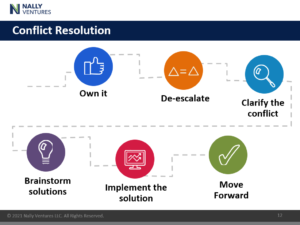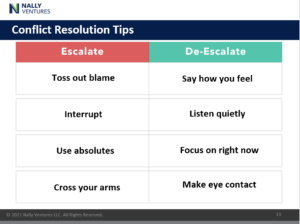
Conflict resolution tactics to make work—and life—more productive
“If we manage conflict constructively, we harness its energy for creativity and development.”
– Kenneth Kaye, American psychologist
It’s easy to think of conflict as a negative…something you want to avoid at all costs. But does it have to be? It can also be an opportunity to better understand the other person or grow your relationship with them. It can be a learning experience for you that changes your mind or opens your eyes to another way of thinking.
Knowing how to resolve conflict productively is a skill all leaders should have in their toolbox. Here’s a conflict resolution process you can use as your go-to.

Take ownership of the conflict.
Think about what you can control, such as your thoughts, feelings and actions, and own those things. What filters may be impacting your perception of the conflict, or the likelihood of you resolving it?
De-escalate.
Be mindful not to make the conflict worse. Your words and actions, including body language, are the difference between escalating and de-escalating the conflict.

Consider the difference between…
- Tossing out blame vs. saying how you feel – When people are accused, they shut down or retaliate. Use gentler but clear statements that express how you feel without placing blame on the other person. Remember, as a leader it is your responsibility to own your emotions and actions. Say, “Sometimes I feel ignored by you” instead of “You always ignore me!”
- Interrupting vs. listening quietly – To solve any issue, you need to step into the other person’s shoes, even if you disagree with them. People think and process information differently and they can have different filters influenced by their experiences, values, beliefs, mindsets, etc.
- Using absolutes vs. focusing on right now – Absolutes like “always” and “never” make the issue larger than life, But focusing on the current situation gives you a clear problem to solve. Say, “You didn’t get back to me earlier today” rather than “You never get back to me.”
- Crossing your arms vs. making eye contact – Body language counts! Eye contact shows you are open to hearing the other person’s side, but crossed arms, finger-pointing, and clenched fists say you’re closed off to them. Lean forward, smile genuinely, nod your head, etc.
Clarify the conflict and both sides.
What’s actually going on at the core of the conflict? What’s the root cause? How big is this problem? What are you really feeling? What about the other person?
Brainstorm a mutually beneficial solution.
You are trying to achieve a win-win. Are the solutions being suggested a win/loss, loss/win, or a loss/loss?
Implement the solution.
Take action and follow through with the solution you agreed on.
Move forward.
Your solution may not be a one-and-done. You may require additional discussions with the other person, and ongoing follow-through. If you stop working on it, a new conflict may come up or the same conflict could continue to fester. Put in the work to move forward, not simply move on.
Most of all, don’t wait! What conflict can you resolve today so it doesn’t fester or snowball into something bigger?
We work with leaders at all levels—from young leaders-to-be to senior executives—to master conflict resolution and other essentials required to effectively lead and manage others. See more about our offerings.
How can we help your leaders and business excel?
